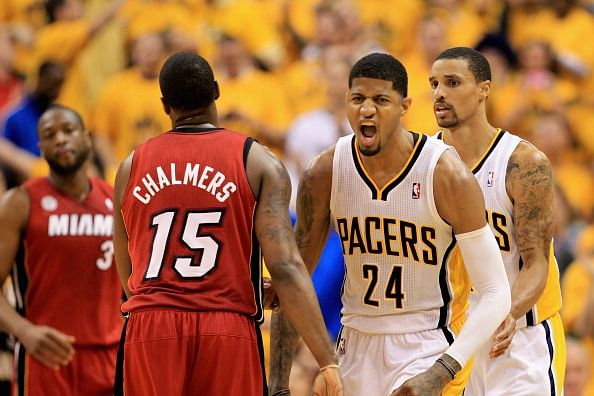
Indiana Pacers: the poor man’s guide to building a winning team

Paul George #24 of the Indiana Pacers celebrates in Game Six of the Eastern Conference Finals during the 2013 NBA Playoffs at Bankers Life Fieldhouse on June 1, 2013 in Indianapolis, Indiana. (Getty Images)
It’s easy – and totally necessary – to get caught up in the moment with the NBA Finals. When there are only two teams left, why bother with the remaining 28? Why not shove them aside and focus on the present, instead of dwelling on the past?
The two remaining teams are the Miami Heat and the San Antonio Spurs. One of them won the rights to a number one pick 16 years ago – Tim Duncan – and built a dynasty around his talents. They were blessed with an all-time great, but they also used some expert scouting to add Tony Parker and Manu Ginobili to their mix, as well as surround this core with many other underrated talents, to contest for their fifth title.
The other team already had a superstar talent in Dwyane Wade, but added two more top five picks and superstars in their prime to make a ‘superteam’ for the ages. At least one of those three players – LeBron James – will be an all-time great like Duncan. And so, our last remaining teams in 2013 comprise of several future Hall of Famers, a four time MVP on one end, and a game-changing big man on the other.
But there was another team – the Indiana Pacers – that came within just one game from preventing this clash of the titans and replacing the world’s best players with their collection of underrated, forgotten talents at the NBA’s last stand. It took a buzzer-beating lay-up by James in Game 1 (thanks to Roy Hibbert’s benching), and a legendary third-quarter takeover by James again in Game 5 to keep the Heat afloat in the Eastern Conference Finals, and still, the Pacers stretched them to a do-or-die Game 7 in Miami. They lost that game in a blowout, but exited with their heads held high; looking forward a bright future.
And if they had conquered the Heat in that make-or-break final game, it would’ve been a victory for the ultimate underdog; not just an underdog in the present, but for a collection of underdogs through the course of their career.
The Heat are defending champs and with their prized 2010 free agent coup, were able to build a franchise around the cream of the 2003 Draft Class: LeBron James (1st), Chris Bosh (4th) and Dwyane Wade (5th). In addition, they have surrounded this frighteningly good talent with some steady role players, including another Hall of Famer in Ray Allen.
The Pacers, on the other hand, couldn’t have been built more differently: no player on that roster was higher than a 9th pick, and even that 9th pick (DJ Augustin) played less than 17 minutes a game this season. So how did they do it? How did a team which plays in a ‘small’ market (Pacers had some of the worst attendance in the league this season), had no ‘game-changing’ talent to build around (no Kevin Durant, no Derrick Rose, Kobe Bryant, or Carmelo Anthony; no LeBron and Duncan even), and no top five pick in recent years become such a major threat to defending champs in the East?

: Indiana Pacers players, from left, David West #21, Paul George #24, Roy Hibbert #55 and George Hill #3 speak with head coach Frank Vogel. (Getty Images)
Credit should go to Donnie Walsh and before him Larry Bird, two men who have laid the blueprint, or the poor man’s guide on how to win a winning team.
Look at the Pacers line-up today and you’ll see a collection of underrated, unappreciated or forgotten stars, who came together to make their way back in to relevance. Indiana constructed this team in the old-fashioned way: drafting smartly, even in low picks, and spending money wisely on their few marquee free agents.
George Hill was the 26th pick in the 2008 draft by the Spurs, and the Pacers traded him for the rights to Kawhi Leonard’s pick in 2011.
Lance Stephenson was the 40th pick in 2010 by Indiana, a former high school superstar who lost his way as he grew older, but the Pacers believed in him and he developed into a solid defender and valuable backcourt scorer for the team.
Paul George was also picked by Indiana in 2010 as their 10th pick. Although he was an athletic talent, few expected that he would develop as an all-round threat and one of the NBA’s most exciting young players so soon. In just his third season, he made the All-Star team, was named Most Improved Player, and is on the brink of superstardom.
David West was picked 18th by the Hornets back in 2003, but since developed into a two-time All-Star alongside Chris Paul in New Orleans before joining Indiana via free agency in 2011.
Roy Hibbert was a big but unproven and unfinished product from Georgetown, but Indiana took a risk on him with their 17th pick in 2008. Within a few years, he developed into an All-Star. This year, he made mincemeat of anyone that tried to step up to him in the paint.